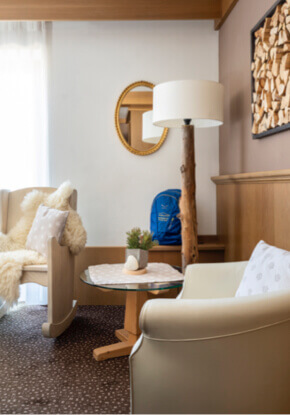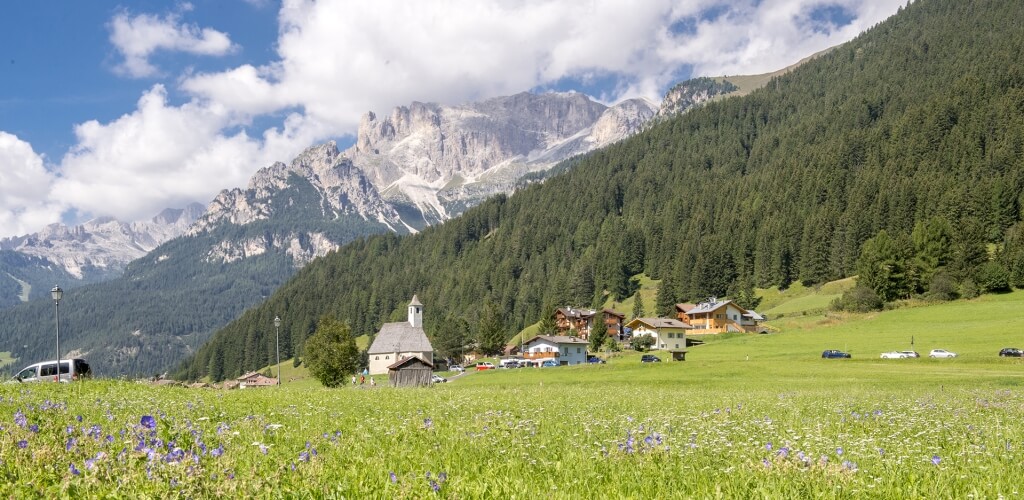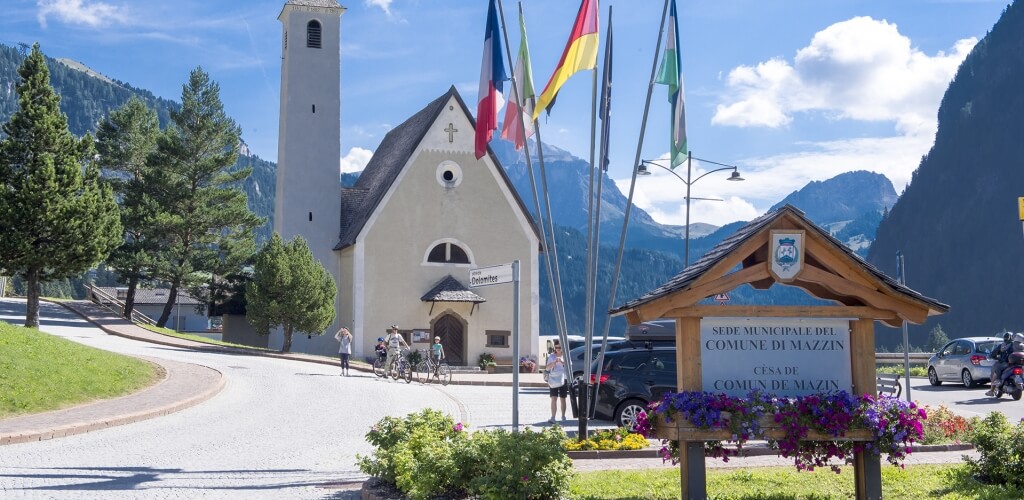Tel: +39 0462 764209
Email: info@hotelcatinaccio.com



Mazzin in Val di Fassa: a corner of genuine tranquility
There is a place, in the heart of the province of Trento, where time seems to have magically stopped, where the frenetic pace and the inexorable ticking of the hands gives all visitors a break from what is the usual and routine daily life.

A relatively small community that seems to come from a world and from a conception of living so far away in time that it seems that modernity has not yet fully taken root here. It is Mazzin, a charming community located in Val di Fassa. Its slightly more than 500 inhabitants make Mazzin the smallest village in the area, also including the tiny hamlets of Campestrin and Fontanazzo.
This narrow strip of land marks, both symbolically and from a purely geographical point of view, what is the beginning of a Val di Fassa whose features are harmoniously designed by majestic mountains and landscapes that will take your breath away from visitors who will keep them heavenly views in the drawer of the most beautiful memories. Here, the Val di Fassa seems to arch, turning its gaze and curving its features towards the North East.
Origins and position
The origins of its denomination envelop the town of Mazzin in a veil of mystery that does nothing but increase its charm exponentially without any physically tangible frontier. The dominant current of thought seems to place the origin of the name in the slang term word ‘macirosc’, which in the very ancient local dialect can be traced back to the milling activity.
The inhabited center of Mazzin is romantically located on the cone of the Rio Udai, and tributary located on the right wall of the Avisio river. This stream divides Mazzin into two parts. Despite a not too easily accessible location, given the structure of the valley, the eye is equally lost in the deepest meanders of a surrounding context, rich in wonders not only natural but also architectural and historical. By pointing your magnifying glass north, it’s impossible to not get attracted to the graceful and special course of the Avisio river mentioned above. And to the south? Well, here the view can only fall on another of the landscape wonders that tuft the area like a leopard: the Vallaccia group. Even further down, in the segment of land that houses the route designed by the state road 48, you can reach the hamlets of Campestrin and Fontanazzo in a rather easy way.
Background
The reputation of this center is as small as it is rich in immeasurable beauty and is, above all, because of the pitores. But what is it about? Especially, in the nineteenth century, the expression pitores indicated all those who, for work reasons, emigrated to the nearby Austro-Hungarian Empire or Switzerland in search of a job that would allow them to guarantee their family a sufficiently dignified lifestyle. Going further into detail, among the craftsmen specialists in the art of decoration, there were very skilled oil painters not only for furniture and doors but also for work tools in general. The pitores’ color table was chromatically essential and not excessively rich, being exclusively composed of colors such as yellow, red, orange, green, black, and blue. Especially as regards the latter color, it was without a shadow of a doubt the most frequently used, so much that it too deserves a dialectal appellation, that of fassanerblau. Obviously, as one could easily deduce, the motifs and subjects painted could be the most diverse, ranging from birds to roses up to the most characteristic and peculiar elements of the autochthonous culture. The objects and tools used at that time by the pitores are still kept, in perfect condition, in the Ladin Museum of Fassa.

What to see
The historic center of Mazzin, visited every year by an ever-growing number of onlookers and visitors, presents within it some works worthy of being taken without batting an eye. The sites mentioned are mostly collected between Via Roma and the banks of the Rio Udai. Those who descend to the valley, using a special underpass, will be able to view an agglomeration of huts which, due to their shape and architectural characteristics, fully and effectively reflect a unique housing concept of its kind. To diversify these houses from the common idea is in particular the presence of two small turrets placed laterally to each, each of which in turn surmounted by a cusp-shaped cover usually manufactured using sheet metal sheets. Not far away, covering a few hundred meters, there is a cemetery and a tiny church, a singular but attractive location for anniversaries that will make refinement their best weapon. To fully enjoy Mazzin, a visit to Casa Battel cannot and should not be missed. Not infrequently called a castle because of the cuspid configuration of its tower, Casa Battel is one of the last surviving remains of a rustic-elegant building to this day. Battel, for the record, was the surname of an influential family that inhabited the Val di Fassa perimeter in past ages. An aspect that intrigues is the set of decorations that beautify and adorn the walls and the contours of the windows. On one of the entrance doors of Casa Battel there is engraved the year 1785. In addition to the decorations just mentioned, the castle also jealously guards some sacred paintings, including one depicting Sant’Antonio da Padova, one in honor of San Floriano and another, certainly among the most beautiful and meaningful, which illustrates the features of St. John the Baptist. Located north of Casa Battel are the prisons of Casa Costazza. In the building in question, signs of wall decorations are still clearly visible, a structure built entirely of masonry which is one of the oldest and best preserved examples of this structural concept. In ancient times, the building hosted the Bishop’s vicar and the prisons, from which his identification name derives. Going back to the valley, between Mazzin and the hamlet of Campestrin, there is the capital of ghosts. A popular legend, transmitted from generation to generation, tells of processions made up exclusively of lights that, like in a grotesque procession, descended towards the valley wrapped in monochromatic and gloomy darkness.
And last, but not least, it is a good and fair thing to include in this prestigious list the attractive site that represents Mazzin’s flagship, that is, the parish church of Santa Maria Maddalena. This ecclesiastical plexus, useful to specify, is positioned in a completely peripheral position to the heart of the village. Its construction, in all probability, dates back to the year of 1573, with its consecration which, however, took place several years later, only in 1582. The bell tower has undergone a remarkable process of renewal in the second decade of the twentieth century, with a painstaking intervention by raising and inserting an additional bell. To reinforce and make the beauty of this church collection irresistible, there are Gothic-style windows that can be found on the side walls of the church. The interior of the parish church of Santa Maria Maddalena consists of a nave and an apse with ribbed vaults. The temporal reference of the primary altar is the mid-seventeenth century, with an invoice made even more precious and sought after by finely carved wood and fake marble. Along the shelves, the sculptures dedicated to San Nicola and San Vescovo are placed. As for the side altar, it has been designed in the form of a wooden anchor that can be located temporally in the year of 1730. In its immediate vicinity there is another statue of Saint Anthony with a child. The entrance door is guarded by two other statues, of Saints Peter and Paul, who symbolically protect the church as sentries. The triumphal arch is in its universality covered with bas-reliefs that illustrate the Mysteries of the Rosary. The effigies of the Via Crucis were introduced only later, in 1815. Finally, concerning the bells, two of them were donated in 1922 by the Bianchi Varese foundry, while the mezzana was produced by the Chiappani foundry in Trento in 1913.
Sign up for our
newsletter!
